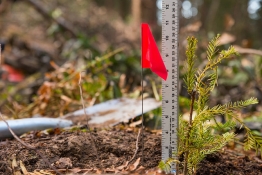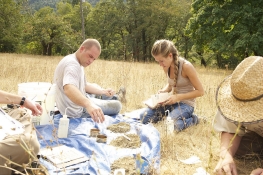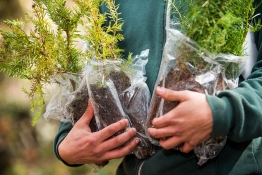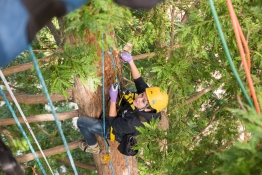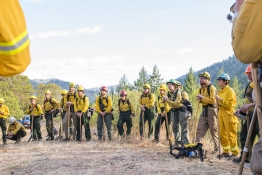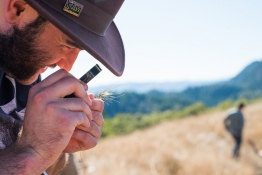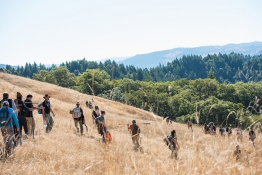Why Forestry?
Forestry isn’t a discipline you learn by simply reading a textbook. You learn through practical experience—a given at Cal Poly Humboldt.
Field Intensive
With the 780-acre Arcata Community Forest at our doorstep, and the newly-acquired Jacoby Creek Forest only 15 minutes away, our students average more than 8 hours per week in the woods during the school year. In addition, we often travel further east to see other, drier forest types.
Careers
A recent survey of our graduates showed that nearly all found jobs in their chosen careers. Their main employers—private companies and governmental agencies such as the U.S. Forest Service—also make lots of summer jobs available to our students, providing an opportunity to make money, establish contacts, sharpen your skills, and see different parts of the western United States.
A Special Community
Despite being the largest forestry department in California (almost 300 students), we remain a cohesive community where classes are small and professors know students by name. Perhaps because of all the time spent outdoors together (especially in the rain!), students routinely form bonds that persist long after they graduate and go on to careers in places far from one another.
Accreditation
 The educational program leading to the Bachelor of Science in Forestry degree is accredited by the Society of American Foresters (SAF), the largest professional forestry organization in the United States. SAF accreditation ensures that a program meets standards set by the profession and increases and enhances employment opportunities for students.
The educational program leading to the Bachelor of Science in Forestry degree is accredited by the Society of American Foresters (SAF), the largest professional forestry organization in the United States. SAF accreditation ensures that a program meets standards set by the profession and increases and enhances employment opportunities for students.
Academics & Options
All concentrations in the Forestry major are accredited by the Society of American Foresters.
General Program Downloads
Forestry Concentrations
and Major Academic Plans (MAP)
Forest Hydrology
This concentration is for students interested in a career in resource management with a focus on water resources. A student who completes this concentration qualifies as a forester for federal employment. By completing a second calculus class, students can be eligible for federal hydrologist positions as well.
Contact Andrew Stubblefield if you have questions or would like more information about this concentration.
Forest Operations
This concentration is for students interested in a career in the forest products industry and consulting. A student who completes this concentration qualifies as a forester for federal employment.
Contact Hunter Harrill if you have questions or would like more information about this concentration.
Forest Restoration
This concentration is for students interested in a career in non-commodity forest management or a career not directly associated with more traditional forestry. A student who completes this concentration qualifies as a forester for federal employment.
Contact Pascal Berrill if you have questions or would like more information about this concentration.
Forest Soils
This concentration is for students interested in a career regarding forest soils and their management issues. A student who completes this concentration qualifies as a forester, soil scientist, and soil conservationist for federal employment.
Contact Susan Marshall if you have questions or would like more information about this concentration.
Tribal Forestry
This concentration is for students interested in both Native American Studies and forestry. It prepares students for a forestry career working with Native American tribes to manage their natural resources. A student who completes this concentration qualifies as a forester for federal employment.
Contact Erin Kelly if you have questions or would like more information about this concentration.
Wildland Fire Management
This concentration is for students interested in a career in managing wildland fuels, prescribed fire, fire suppression, or fire ecology. A student who completes this concentration qualifies as a forester for federal employment.
Contact Jeff Kane if you have questions or would like more information about this concentration.
Program Learning Outcomes
- Identify and describe the physical, chemical, and biological characteristics of forests and other wildland ecosystems
- Explain the ecological, hydrological, edaphic, social, political, and economic structures and processes related to forest and wildland ecosystems across spatial and temporal scales
- Measure, calculate, analyze, and model forest resources and associated processes utilizing mathematics, statistics, and geospatial tools
- Communicate about forest and wildland ecosystems effectively in oral and written formats
- Comprehend and utilize scientific publications in the fields of forestry, ecology, hydrology, rangelands, and soils
- Use critical thinking skills to apply multidisciplinary knowledge of forest resources, policy, administration, and economics to manage forest and wildland resources for diverse objectives
- Become ethical professionals with a sense of life-long learning and curiosity who contribute to developing sound policy and addressing social needs related to forest and wildland resources


